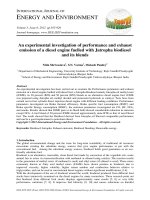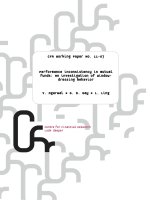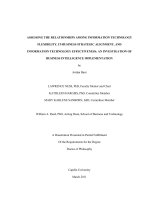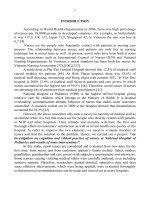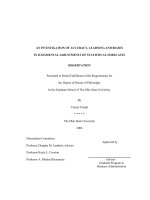Contractor led procurement an investigation of circumstances and consequences
Bạn đang xem bản rút gọn của tài liệu. Xem và tải ngay bản đầy đủ của tài liệu tại đây (8.38 MB, 258 trang )
Christoph Winter
Contractor-led Procurement
GABLER EDITION WISSENSCHAFT
Baubetriebswirtschaftslehre und
Infrastrukturmanagement
Herausgegeben von Professor Dr.-Ing. Dipl.-Kfm. Dieter Jacob
Technische Universitat Bergakademie Freiberg
FOr internationales Zusammenwachsen und Wohlstand spielt gutes
Infrastrukturmanagement eine zentrale Rolle. Erkenntnisse der baubetriebswirtschaftlichen Forschung konnen hierzu wichtige Beitrage
leisten, die diese Schriftenreihe einem breiteren Publikum zuganglich
machen will.
Christoph Winter
Contractor-Led Procurement
An Investigation of Circumstances and
Consequences
With a Foreword by Prof. Dr.-Ing. Dipl.-Kfm. Dieter Jacob
Deutscher Universitats-Verlag
Bibliografische Information Der Deutschen Bibliothek
Die Deutsche Bibliothek verzeichnet diese Publikation in der Deutschen
Nationalbibliografie; detaillierte bibliografische Daten sind im Internet tiber
<> abrufbar.
Dissertation Technische Universitat Bergakademie Freiberg, 2002
1. Auflage Dktober 2003
Aile Rechte vorbehalten
© Deutscher Universitats-Verlag!GWV Fachverlage GmbH, Wiesbaden 2003
lektorat: Brigitte Siegel! Annegret Eckert
Der Deutsche Universitats-Verlag ist ein Unternehmen der
Fachverlagsgruppe BertelsmannSpringer.
www.duv.de
Die Wiedergabe von Gebrauchsnamen, Handelsnamen, Warenbezeichnungen usw. in diesem
Werk berechtigt auch ohne besondere Kennzeichnung nicht zu der Annahme, dass solche
Namen im Sinne der Warenzeichen- und Markenschutz-Gesetzgebung als frei zu betrachten
waren und daher von jedermann benutzt werden dtirften.
Umschlaggestaltung: Regine Zimmer, Dipl.-Designerin, Frankfurt/Main
Gedruckt auf siiurefreiem und chlorfrei gebleichtem Papier
ISBN-13: 978-3-8244-7947-4
001: 10.1007/978-3-322-81614-6
e-ISBN-13: 978-3-322-81614-6
v
Foreword
Foreword
This is the second title in a series which is aimed at giving access as widely as possible
to the results of our research into construction business management. We wish to
express our gratitude to Gabler to have put their faith in us.
Christoph Winter, who was the first research assistant to join the newly created chair,
combines knowledge
and practical
experience
of Anglo-Saxon construction
management with awareness of the German construction environment. The AngloSaxon countries have not experienced a period of reconstruction, as has occurred after
the reunification of Germany, and have thus experienced life-threatening competition
much earlier. Contractors in offering producer-led and collaborative procurement have
developed instruments to strengthen their competitive position. These are the thoughts
that this work now introduces into Germany.
As a true compendium this work is not only directed upstream at the client, but also
downstream, adopting a resource orientated look at integrating subcontractors and other
suppliers most effectively into the supply chain, in order to facilitate contractor-led
procurement in the first place, despite the difficulties of seasonal one-off and prototype
production at ever changing locations. Midstream relationships in form of collaborative
working or partnering are being considered as well.
Christoph Winter has come to the newly founded chair with this idea already in mind
and has continuously developed the theme during all that time. In one move he has
highlighted the entire topic of producer-led and collaborative procurement as a means
for competitive advantage in the construction industry. It is a truly pioneering piece of
management science for the German construction industry, especially in respect of
marketing issues and supply chain management. He has done so in a knowledgeable and
professional manner with practical applications in mind. All in all it is an unusually
robust and substantial piece of work of a senior professional and is not merely a product
from the heights of academia. He has succeeded in presenting this most important topic
for the construction industry from a national and international perspective in a concise
manner. We can only wish for the work to find as many readers as possible. The
VI
Foreword
publication of this dissertation as a book by Gabler Edition Wissenschaft is a significant
step in the right direction.
Prof. Dr. Dieter Jacob
Preface
VII
Preface
The construction industry is facing an increasingly competitive environment the world
over, where greater pressure for change on the existing procedures of the construction
industry is brought about by the more powerful of its clients. Clients, who themselves
are confronted by the effects of globalisation.
The urgent need for organisations of the construction industry, whether they are
contractors or consultants to adapt to their environment in terms of organisational
structures and strategy sets the backdrop against which the appropriateness of
contractor-led procurement, its circumstances and consequences is to be presented.
This book considers the circumstances that bear directly and indirectly on a contractor's
competitive position in variety of construction markets in terms of the roles that various
clients take in demanding construction services, in terms of consultants' influence on
the construction development process and in terms of the role that the supply chain must
fulfil for the accomplishment of successful construction projects.
It appears that meeting clients' demands for a ready purchase of design, procurement
and management of construction from a single source is most successfully managed by
the adoption of a producer-led procurement path, especially when expecting high levels
of efficiency, cost certainty, productivity and quality levels. At the same time a
competent main contractor will need to know when it is safe to single source from a
supplier, when it is appropriate to undertake joint ventures or when preferred or market
place supplier tendering is the most effective method of sourcing a construction project.
He has to optimise business relationships and early involvement with his supply chain
and be expert in handling consultants, specialist contractors and material suppliers as
not only befits a single, but a succession of projects for a variety of clients and project
types.
To this end tools are presented that allow a suitable selection of procurement route to be
made from a client's perspective and determine the preferred business relationships
between main contractor and his supply chain. These are neither too prescriptive nor
VIII
Preface
complex as to prevent their use in every day practical situations and will be of help in an
increasingly dynamic and complex construction market.
I would like to thank my colleagues and students at the Chair of Construction Business
Management of the Freiberg University of Mining and Technology for their help and
valuable feedback when writing the dissertation, and also many other members of the
construction industry who in discussion have contributed in some way. I am especially
indebted to my supervisor Prof. Dr. Dieter Jacob whose encouragement, assistance and
support has made this work at all possible. My thanks are also due to Prof. Dr. Margit
Enke and Prof. Dr. Bernd Kochendorfer for their support and critical, yet positive,
reviews. Finally, I wish to express my gratitude for the patience and tolerance of my
wife, Helga, and two sons, Paul and Joseph, for their support and encouragement during
the preparation and writing of this work.
Christoph Winter
Contents
IX
Contents
List of Figures and Tables .................................................................................... XIII
List of Acronyms and Abbreviations ................................................................... xv
1. Introduction ............................................................................................................... 1
1.1 Abstract ................................................................................................................ 1
1.2 Objective .............................................................................................................. 2
1.3 Purpose ................................................................................................................. 3
2. The Construction Industry and its Participants ................................................ 5
2.1 The construction environment, market, industry and its participants .......... 5
2.1.1 The environment, market and industry in general ....................................... 5
2.1.2 Construction environment ......................................................................... 10
2.1.3 Construction markets ................................................................................. 12
2.1.4 Construction industry ................................................................................ 18
2.1.5 Participants of the construction industry ................................................... 19
2.2 Development trends in the construction industry structure ......................... 26
2.2.1 Clients ........................................................................................................ 26
2.2.2 Consultants ................................................................................................ 36
2.2.3 Contractors ................................................................................................ 41
2.3 Analysis of trends in the construction industry structure ............................. 52
2.3.1 The pressures of change ............................................................................ 52
2.3.2 Analysis of clients' behaviour and the consequences ............................... 53
2.3.3 Analysis of contractors' behaviour and the consequences ........................ 56
3. Overview of Construction Procurement Types ............................................. 65
3.1 Introduction ....................................................................................................... 65
3.2 Differentiating between procurement systems and generic procurement
techniques .......................................................................................................... 67
3.3 Types of procurement systems ......................................................................... 68
3.3.1 Classification of procurement types ........................................................... 68
3.3.2 Presentation of procurement types ............................................................. 70
3.3.3 Design-led tendering .................................................................................. 72
3.3.4 Management-led tendering ........................................................................ 77
3.3.5 Producer-led tendering ............................................................................... 84
3.4 A guide to the procurement selection process ................................................ 88
3.4.1 Problems encountered during selection ..................................................... 88
3.4.2 Organisational features of projects ............................................................ 89
3.4.3 Management approaches for determining selection criteria ...................... 90
3.4.4 Client criteria.............................................................................................. 92
3.4.5 Project criteria ............................................................................................ 94
3.5 A general procurement selection modeL ........................................................ 95
X
Contents
3.6 Standard construction contracts ...................................................................... 99
3.6.1 Standard documents in the United States ................................................. 100
3.6.2 Standard documents in the United Kingdom ............................................ 102
3.6.3 International standard documents ............................................................. 103
4. Contractor-led Scenarios .................................................................................... 106
4.1 Introduction ..................................................................................................... 106
4.2 Organisational features of contractor-led procurement .............................. 107
4.3 Positive features of contractor-led procurement .......................................... 110
4.3.1 Positive features of contractor-led procurement
in respect of time ...................................................................................... 110
4.3.2 Positive features of contractor-led procurement
in respect of cost ...................................................................................... 113
4.3.3 Positive features of contractor-led procurement
in respect of quality .................................................................................. 117
4.4 Less favourable circumstances of contractor-led procurement .................. 121
4.4.1 Circumstances less favourable for contractor-led procurement
in respect of time ...................................................................................... 121
4.4.2 Circumstances less favourable for contractor-led procurement
in respect of cost ...................................................................................... 122
4.4.3 Circumstances less favourable for contractor-led procurement
in respect of quality .................................................................................. 125
4.5 Appropriate application of contractor-led procurement ............................. 128
4.5.1 Analysis of positive and less favourable features of
contractor-led procurement ...................................................................... 129
4.5.2 Two examples of Design and Build projects ............................................ 133
4.5.3 Preferred application of contractor-led procurement ............................... 137
4.5.4 Some references to German contracting practice ..................................... 144
5. The Relationships of a Design and Build Contractor with other
Participants ............................................................................................................ 147
5.1 The Design and Build contractor and clients ................................................ 147
5.1.1 General comments concerning the contractor-c1ient relationship ........... 147
5.1.2 Experienced clients and the concept of "partnering" ............................... 154
5.1.3 Inexperienced and occasional clients ....................................................... 158
5.1.4 Public sector clients .................................................................................. 160
5.2 The Design and Build contractor and consultants ....................................... 161
5.2.1 The relationship between contractor, consultants and designers ............. 161
5.2.2 Good practices for the relationship between contractor and consultants. 163
5.2.3 Alternative approaches for design completion......................................... 165
5.3 The nature of contractor to contractor relationships .................................. 171
5.3.1 Types of contractor relationships ............................................................. 171
5.3.2 Specialist contractors and subcontractors ................................................. 175
5.3.3 Current nature of main contractor-subcontractor relationships ................ 178
Contents
XI
6. Working with Subcontractors ........................................................................... 188
6.1 Issues to consider when working with subcontractors ................................ 188
6.1.1 The need for subcontracting ..................................................................... 188
6.1.2 Risk management in procurement... ......................................................... 189
6.1.3 The ideal and limitations of early supplier involvement.. ........................ 192
6.2 Selecting the right governance structure for main contractor-supplier
business relationships ..................................................................................... 199
6.2.1 Current approaches .................................................................................. 199
6.2.2 Procurement classification and strategies for a Design and Build
contractor ................................................................................................. 200
6.2.3 A Design and Build contractor's procurement choices ........................... 204
6.2.4 Systematic approaches to procurement market research ......................... 206
6.3 Behaviour and control exercised in contractor-led procurement .............. 207
6.3.1 Good tendering and estimating practice ................................................... 207
6.3.2 Competitive versus negotiated supplier selection .................................... 213
6.3.3 Supplier appraisal and development ........................................................ 213
6.3.4 Early involvement tools ........................................................................... 214
6.3.5 Control of the project development process ............................................ 217
7. Review ................................................................................................................... 220
7.1 Summary .......................................................................................................... 220
7.2 Conclusion........................................................................................................ 223
7.3 Outlook ............................................................................................................. 225
References .................................................................................................................. 227
Appendix .................................................................................................................... 239
List of Figures and Tables
xm
List of Figures and Tables
Figure 1:
Figure 2:
Figure 3:
Figure 4:
Figure 5:
Figure 6:
Figure 7:
Figure 8:
Figure 9:
Figure 10:
Figure 11:
Figure 12:
Figure 13:
Figure 14:
Figure 15:
Figure 16:
Figure 17:
Figure 18:
Figure 19:
Figure 20:
Figure 21:
Table
Table
Table
Table
Table
Table
Table
Table
Table
1:
2:
3:
4:
5:
6:
7:
8:
9:
Table
Table
Table
Table
Table
Table
Table
Table
10:
11:
12:
13:
14:
15:
16:
17:
Elements of industry structure ....................................................................... 6
National Diamond ......................................................................................... 7
Influence of design changes on costs .......................................................... 28
Trends in construction procurement spend 1995-2005 ............................... 30
Services offered by BDP ............................................................................. 39
Proportion ofal! contractors according to size class .................................. .47
Growth in number of contractors according to size class .......................... .48
Development of tumover per employee according to size class ................ .49
Procurement types ....................................................................................... 70
Traditional procurement structure ............................................................... 73
Management-led tendering / Construction Management ............................ 79
Management-led tendering / Management Contracting .............................. 80
Design and Build ......................................................................................... 85
General procurement selection model ......................................................... 97
Framework for the selection of consultants by a Design and Build
contractor ................................................................................................... 170
Prioritisation and management of risks ..................................................... 190
Interrelationship between risk, cost, design and contract management .... 191
Procurement classification ........................................................................ 201
Example of procurement strategy choices ................................................. 205
Preferred marketing approach to procurement.. ........................................ 207
Relationship between bid frequency and bid cost.. ................................... 212
Clients' drivers for construction projects in UK ......................................... 21
Market share and firm size indices (in the UK) .......................................... 46
Ownership composition of subcontracting firms (in the USA) .................. .49
Terminology for different procurement groups ........................................... 69
Procurement paths suggested for further analysis ....................................... 98
Comparison of work by different procurement methods .......................... 107
Correlation between procurement types .................................................... 145
Advantages and disadvantages of design completion methods ................ 169
Correlation between subcontractor selection procedures
and type of main contract .......................................................................... 182
Comparison between results and the recommendations of the code ......... 184
Ranking of statements received by subcontractors ................................... 185
Reasons for subcontractors' difficulties .................................................... 186
Factors that influence subcontractors' willingness to bid ......................... 187
Procurement choices ................................................................................. 202
Main contractor's subcontractors and suppliers ........................................ 205
Number of tenders recommended ............................................................. 209
Tendering times ......................................................................................... 21 0
List of Acronyms and Abbreviations
List of Acronyms and Abbreviations
%
per cent
approx.
approximately
bn.
billion
BOT
Build, Operate, Transfer
e.g.
for example
etc.
and the rest
GDP
Gross Domestic Product
Ibid.
in the same place
IT
Information Teclmology
m.
million
p.
page
pp.
pages
QS
Quantity Surveyor
UK
United Kingdom
US
United States
USA
United States of America
XV
Introduction
1.
Introduction
1.1
Abstract
Major clients of the construction industry have been found to organise construction
work into fewer, but larger, contracts with more transfer of risk and responsibilities in
response to a change from a sellers' market to a buyers' market, and facing a greater
choice of procurement methods than ever before.
Main contractors and consultants alike are moving towards multidisciplinary teams
offering design and management services, challenging single service consultants or
contractors and are in competition with each other over who is leading the process. A
consolidation of firms at the upper end of the industry can be witnessed in order to
access a wider market and new clients, and at the lower end a specialisation into specific
skills or locations takes place, while medium sized firms are increasingly struggling to
survive.
A general procurement model serves to identify the appropriate procurement approach
for construction needs, as neither clients or construction service suppliers represent a
homogenous market. Clients' demands for a ready purchase of design, procurement and
management of construction from a single source have been found to be met most
appropriately by contractor-led procurement under most, but not all, circumstances,
particularly in respect of higher levels of efficiency, cost certainty and punctuality
among other benefits.
The consequences faced by a contractor in the leading role of the procurement process
are significant, especially in terms of integrating and co-ordinating the entire supply
chain to the satisfaction of the client and for anticipated repeat business. This is the
chief factor of competitive strength for the struggle of long term survival. A
classification model of procurement strategies in respect to parameters of supply risk,
strategic importance and frequency of spend offers a tool for the appropriate choice of
business relationship with different suppliers.
C. Winter, Contractor-Led Procurement
© Deutscher Universitäts-Verlag/GWV Fachverlage GmbH, Wiesbaden 2003
Introduction
2
It is to be anticipated that the future will see an intensification of the changes in the
processes of construction procurement described and analysed, which may vary in
extent from one market to another, but not in direction.
1.2
Objective
The construction industry is facing an increasingly competitive environment the world
over, where greater pressure for change on the industry's procedures is brought about by
the more powerful of its clients, who themselves are confronted by the effects of
globalisation. The urgent need for firms of the construction industry, whether they are
construction organisations or consultants, to adapt to their environment in terms of
organisational structure and strategy sets the backdrop
against which the
appropriateness of contractor-led procurement, its circumstances and consequences, is
to be investigated.
The nature of the circumstances that bear directly and indirectly on a contractor's
competitive position in a variety of construction markets has to be considered in terms
of the roles that various clients take in demanding construction services, in terms of
consultants' influence on the construction development process and in terms of the role
that the supply chain must fulfil for the accomplishment of successful construction. The
effects that these changes have on the participants of construction, who are clients,
consultants, contractors and suppliers, must be identified and the consequences
analysed.
Within this context, the contractor as producer and in the leadership position of the
construction procurement process, from first contact with the client to the completion
and possible operation of a building or facility, must master the effective organisation
and handling of the supply chain including design, which must be addressed in terms of
the benefits and difficulties that face client and contractor alike.
Introduction
1.3
3
Purpose
The need to arrive at a meaningful and substantiated outcome to the question of whether
contractor-led procurement in construction is appropriate under the actual circumstances
that participants of the industry are confronted with and their possible consequences,
requires that a large body of literature from a variety of sources and origins is referred
to, aimed to achieve an up-to-date account of the situation in the construction industry
in some of the major construction markets of the world.
The environment, the market and the industry, together with the participants of
construction are described, and placed in context to create a position from which
judgement can be passed on the trends in the construction industry and the consequent
changes that occur as a result in the behaviour of its key players: the clients, consultants,
contractors and suppliers.
The array of procurement types in construction is explained, divided into three distinct
groups and presented together with a general procurement selection model based on
client and project criteria, which is illustrated by a number of worked examples. The
importance that a variety of standard contracts has on the procurement process in the
United States, the United Kingdom and internationally is referred to.
Concentrating on the benefits and less favourable aspects of contractor-led procurement
in respect of time, cost and quality, the circumstances for the successful application of
this type of procurement path are analysed, preferences stated and supported by two
brief examples of actual projects. Parallels to German contracting conventions are
drawn.
The consequences as a result of such an approach to construction procurement on the
relationship between contractor and other participants, especially its range of suppliers
including subcontractors, is investigated and, since the ability of organising and coordinating the supply chain is of prime importance, a number of issues, not least the
selection of the preferred types of contractor-supplier business relationships, are
examined.
4
Introduction
The overall effect, designed to achieve an objective description and evaluation that
compares the application of contractor-led procurement in contrast to other procurement
methods, is supported by an examination of the benefits and difficulties associated with
such an approach. AJ; a result the appropriate application of contractor-led procurement
and the consequences thereof are examined in the light of what is required to have a
construction client fulfil his construction needs as efficiently as possible.
The Construction Industry and its Participants
2.
The Construction Industry and its Participants
2.1
The construction environment, market, industry and its participants
2.1.1
The environment, market and industry in general
5
All organisations are faced by an environment that includes everything considered to be
outside of a company that either affects it directly or indirectly. While those aspects that
define the environment can be described as simple and static or complex and dynamic,
in practice the situation encountered is one that ranges from low to high levels of
complexity and dynamism I.
A distinction is made between an industry, an arbitrary boundary within which finns are
in competition within each other producing products or providing services, and a market
that is any organisation where buyers and sellers are in close contact to detennine the
price of a product. "Industry" is a supply side concept, while ''market'' is a demand side
concept. There are related industries that produce products and services that share
customers, techniques or channels, but they have their own unique requirements for
competitive advantage. In practice, drawing industry boundaries is essentially a matter
of degree2 • A framework of competitive forces that detennine an industry structure and
largely explains the behaviour of its members is influenced and shaped by an
interdependent relationship with its market, as shown in the illustration on page 6.
The strength of each of the five competitive forces is a function of industry structure,
which is relatively stable, but can change over time as an industry evolves influenced
both by environmental forces and finns' strategies3. Industry structure detennines who
captures the value created by finns for buyers, where, for example, the threat of entry
detennines the likelihood that new finns will enter an industry and compete away the
value, either passing it on to buyers in the fonn of lower prices or dissipating it by
raising the cost of competing. The power of buyers detennines the extent to which they
retain most of the value created for themselves. The threat of substitutes detennines the
extent to which some other product or service can meet the same buyer needs and thus
see, for example, Waiker,1996,pp. 56.78.
1990, pp. 33.
3 Porter, 1985, p. 7.
I
2 Porter,
C. Winter, Contractor-Led Procurement
© Deutscher Universitäts-Verlag/GWV Fachverlage GmbH, Wiesbaden 2003
6
The Construction Industry and its Participants
places a ceiling on the amount a buyer is willing to pay for an industry's product. The
power of suppliers determines the extent to which value created for buyers will be
appropriated by suppliers rather than by finns in an industry and finally, the intensity of
rivalry acts similarly to the threat of entry4.
Entry Barriers
economies of scale
proprietary product differences
brand identity
switching costs
capital requirements
absolute cost advantages
government policy
expected retaliation
I New Entrants I
Threat of
new entrants
Determinants of Buyer Power
bargaining levemge:
buyer concentration vs. finn concentration
buyer volume, buyer switching costs, buyer
infonnation, ability to backward integrate,
substitute products, pull-through
price sensitivity:
price/total purchases, product differences,
brand identity, impact on quality/performance,
buyer profits, decision makers' incentives
Industry
Bargaining power
Competitors
Bargaining power
ofhuyers
rs~~~~O~fS~UW~li~e~~__~
~~~~---1 Buyers
I Suppliers
l
Intensity of
Determinants of Supplier Power
rivalry
differentiation of inputs
switching cost of suppliers and firms in the industry
presence of substitute inputs
Threat of
supplier concentration
substitutes
importance of volume to supplier
cost relative to total purchases in the industry
Substitutes
impact of inputs on cost or differentiation
threat of fOJWard integration relative to threat of
backward integration by firms in the industry
I
Determinants of
Substitution Threat
relative price performance
of substitutes
switching costs
buyer propensity to substitute
Rivalry Determinants
Industry growth, fixed costs/value added, intennittent over",apacity, product differences, brand identity, switching costs,
concentration and balance, infonnational complexity, diversity of competitors, corporate stakes, exit barriers
Figure I: Elements of industry structure5
The nature of a market, particularly on a national scale, which is to explain the
characteristics and possible success or failure of an industry, has been carefully
analysed and described by Porter6, who has derived the "national diamond" model
referring to a system of four broad attributes that shape the environment and market in
which an industry competes and is further influenced by two additional variables of
government and chance events, as represented diagrammatically over the page.
Ibid. pp. 8.
Ibid. p. 6.
6 Porter, 1990, pp. 27.
4
5
The Construction Industry and its Participants
'
7
\
......
'----...-----' \>"
,
"
\,\
\
Figure 2: National Diamond7
The "diamond" is a mutually reinforcing system, with the effect of anyone determinant
being contingent on the state of the others and a market which displays a favourable
combination of these in respect of a particular industry is likely to advance it across
national boundaries. The four determinants can be briefly described as follows:
•
Factor conditions, which describe a nation's position in factors of production, such
as skilled labour or infrastructure (physical or services), necessary to compete in a
given industry.
•
Demand conditions, that explain the nature of home demand for the industry's
product or service.
•
Related and supporting industries, where presence or absence in the market of
supplier industries and related industries that are internationally competitive.
•
Firm strategy, structure and rivalry, which describes the conditions in the nature of
markets governing how companies are created, organised and managed and the
nature of domestic rivalry. The latter is described in detail by the elements of
industry structure.
1
Ibid. p. 127.
8
The Construction Industry and its Participants
By market structure is nonnally meant the degree of concentration or distribution of
market shares, which is the proportion of all transactions in a product or service
involving a buyer and seller. Market structure is also concerned with the extent of
product differentiation. By providing a distinct product or service, a finn is in a position
to protect its own market share from changes in the prices of other finns, at least to
some degree. It is attempted to acquire a niche in the market, a gap not covered by
existing products or services provided by competing finns. The purpose being to create
a situation in which direct comparisons between products and services is difficult and as
a result to be able to increase profit / gross margin.
Differentiation in construction markets presents a rather different problem to the more
usual text book example of product differentiation by producers. Under traditional
construction contracting systems it is clients with their designers acting as agent and not
the producer finns who specify and control the fonn and content of the build product.
This has shifted the focus of attention from the product to the type of service undertaken
by contracting finns. In tum, this has led to the description of the product of the
construction finn not as the building but as a construction service. As such, it is possible
to point out differences between finns competing for the same project in tenns of
differences in the service provided, although the final building might be identical in
tenns of its appearance, regardless of the contracting finn employed. However, the rules
of simple selective competitive tendering on price alone (as is the case with the public
sector in most countries) contains the assumption that all tenderers are equivalent or
undifferentiated in tenns of the quality of the services they are offering. Differentiation
is at best confined to a simple one dimensional sorting of finns into approved and nonapproved or tender listed and non-listed finns 8 •
Another method that can be adopted alternatively by oligopolistic9 finns is collusion,
where price and output of each producer and the allocation of work and market shares is
8
9
Gruneberg and lve, 2000, pp. 91.
Oligopoly refers to a market in which a few fmns, which dominate the market, are obliged to enter into
a variety of non-price competition such as advertising, promotion and corporate imaging. They create a
situation in which direct comparison between products is difficult, by introducing imperfections into the
market and product differentiation, in order to increase gross margins. Price competition between
oligopolistic firms would be destructive; see: Ibid. p.93.
The Construction Industry and its Participants
9
predetennined by the firms, enabling higher prices to be charged than would otherwise
have been the case if normal competition had prevailed.
Barriers to entry are another feature of markets, where firms in a market will tend to set
higher margins then they would if they feared the arrival of new entrants. High barriers
to entry bring stability to sets of rival firms. Market barriers to entry include lO :
•
Economies of scale, where barriers are associated with the concept of minimal
efficient scale of production, below which it would be uneconomic to set up in
competition with existing firms and the concept of customer loyalty to existing
suppliers or providers.
•
Supply chains, where vertical integration or long term contractual arrangements are
established with other firms in the production supply chain, which can form
effective barriers to new firms.
•
Incumbents' cost advantages, where established firms are protected from
competition by new entrants if the latter will be unable, on entry, to match the
former's level of costs, for example, where experience and learning - curve effects
are strong. On the other hand, if there is technological improvement in production
methods or in service delivery, existing firms may be left with obsolete, higher cost
plant or less effective forms of service delivery.
•
Private information, where existing firms possess either private or proprietary
knowledge and are in a position to take advantage of information not known by
other firms, or is protected by ownership rights, copyright and patents. Established
firms may have knowledge about customers, subcontractors, suppliers and
competitors that new entrants will not have. This information is not shared and lack
of it forms a barrier to entry. Often, this type of technological or market information
not generally available outside a firm will actually be known by certain individuals
currently employed by that firm. It is open to a new entrant to try and acquire this
private knowledge by poaching these employees and represents a problem
particularly for firms following strategies of "relational contracting".
10
Ibid. pp.97.
10
•
The Construction Industry and its Participants
Client imposed barriers to entry, referring to clients only short-listing tenderers who
can demonstrate past experience on similar projects or have been able to pass
client's pre-selection criteria.
2.1.2 Construction environment
The process of providing a project is a response to the actions of the environment,
which acts in two ways upon the process, indirectly upon the activities of the client of
an individual project and directly upon the process itself. At its root, it is the action of
forces of the environment on the client's organisation that triggers the need for
construction work by responding in order to survive, or to take an opportunity to
expand, become more efficient and as a result requiring construction work to be
undertaken and providing the construction industry with work. At a strategic level, it
will determine how the building should be provided, dependent upon the property
market, the technology of the process and may trigger changes to the proposed building
required by the client during design or construction. The environmental forces acting
directly on the design and construction process cart affect the ability of the process to
achieve what the client wants. International projects especially have extremely complex
environments, where not only the environment generated by the country in which the
project is built, but also the environment of the countries providing the construction
team and supplies have to be taken into account 11.
The environmental influences acting directly upon the client's organisation, therefore,
should determine the organisation structure and mode of operation appropriate to the
client's activities. Environmental influences will present opportunities to the client as
well and will determine the manner in which such opportunities need to be taken. For
example, a client's environment may determine that an additional manufacturing
capacity needs a building quickly in order to take advantage of an opportunity. It is thus
in the best interest of the client to set up an organisation that is capable of acting quickly
to achieve this. If, at the same time, forces indicate a degree of uncertainty of the nature
of the market for the product, then the organisation set up to take advantage of the
situation must also be capable of achieving the flexibility required. This need may occur
\I
Walker, 1996, pp. 62.
The Construction Industry and its Participants
11
at the time of a rise in activity in the building industry, thus creating uncompetitive
conditions in terms of price and completion time for the project. The construction
process is, therefore, made complex by the type of environment in which it exists, it
must produce a clearly defined solution at the technical level of design and construction
but must also remain flex~ble and adaptive to satisfy environmental requirements.
The construction industry's professional and industrial firms, meanwhile, have for many
years not adapted a great amount to their environment, as illustrated by the large
proportion of projects undertaken predominantly in the conventional pattern in spite of
much criticism of this process. The conventional pattern tends to be self-regulating and
to function to maintain the given structure of the system, it existing in an environment
from which it protects itself. This is achieved through codes of conduct and fee scales of
its professional institutions, sometimes established in law l2 , which eliminates to a large
extent competition between firms, enabling the system to resist change and maintain the
status quo. However, the increasingly complex and competitive environment and
increasing speed of change in which the system and its clients have to exist have been
significant in breaking down such practices, at different rates in different parts of the
world, with the Anglo-American sphere of influence leading this process of adaptation.
The increasingly multinational nature of the industry's clients and overseas practice
have been a major force for change as clients are experiencing novel methods of
managing construction procurement to those found at their home base.
At project level, it appears that some clients are adapting by changing the nature of the
building process, for example, by introducing the contractor into the design team and so
moving nearer to an open adaptive system of construction procurement.
Adaptation at project level takes place in many parts of the world, form the United
States across many European States to the Far East and Australasia, especially where
large scale projects are underway in response to clients' demands, in respect of
traditional institutional domination of the professions and industry firms and their
respective representative institutions. This was only possible for projects with clients
who themselves were adaptive and not protected in some way from their own
12
For example, the Honorarordnung fiir Architekten und Ingenieure (HOAI) in Germany.
The Construction Industry and its Participants
12
environments, as opposed to public sector clients, which tend to be protected to some
extent.
The process of providing a construction project should be an open adaptive system, but
in practice it is always constrained by the environment within it exists, which varies
from one market to another. Nevertheless, the process needs to change its structure, if
environmental events, acting either directly upon the process or indirectly through the
client's organisation, dictate that this should happen 13 •
2.1.3 Construction markets
The process involved in determining prices in the construction market is turned upside
down, as the client initiates the product and the contractor traditionally has little control
over the contract, where price is largely agreed before the contract starts. In addition, the
price provides the basic criterion for much of contractor selection. Therefore, the market
structure for contracting involves reverse price determination, a reverse auction, with
one buyer and competing sellers for a pre-demanded project. This determines the
competitive arena, which is client generated and largely of a short term focus for the
majority of transactions (i.e. for the duration of a project). Typically, other features
encountered in construction markets are a large number of small value orders, extensive
division of labour and specialisation of skills, minimal vertical integration and limited
advantages of scale, all of which are compatible with industrial fragmentation. Existing
barriers are perceived to be low, since l4 :
•
•
low cost of entry is thought to prevail as contractors rely upon human capital.
expertise and know-how can readily be brought in, the level of which depending on
the financial resources available.
•
there are presumed to exist only constrained opportunities for limit pricing
strategies.
•
it is thought that pre-demand limits the effectiveness of marketing, and
•
economies of scale are thought unpredictable as characteristics change with each
project.
13
14
Ibid. p. 72.
Gruneberg and Ive, 2000, pp. 97.
